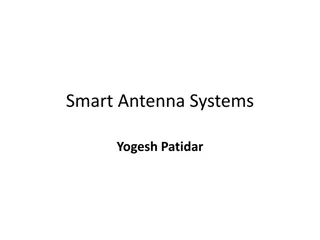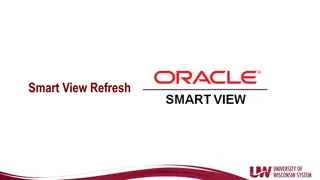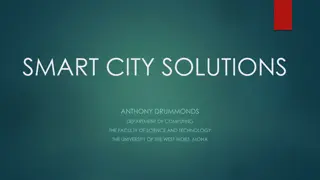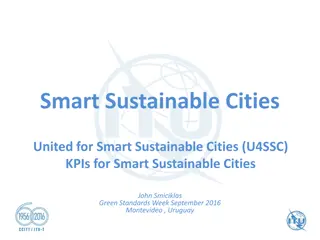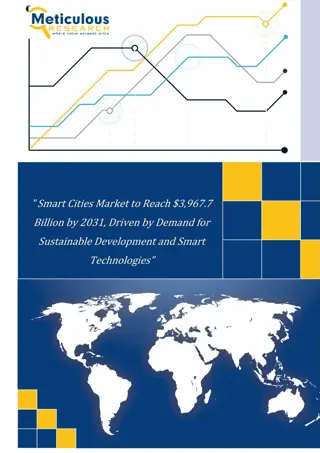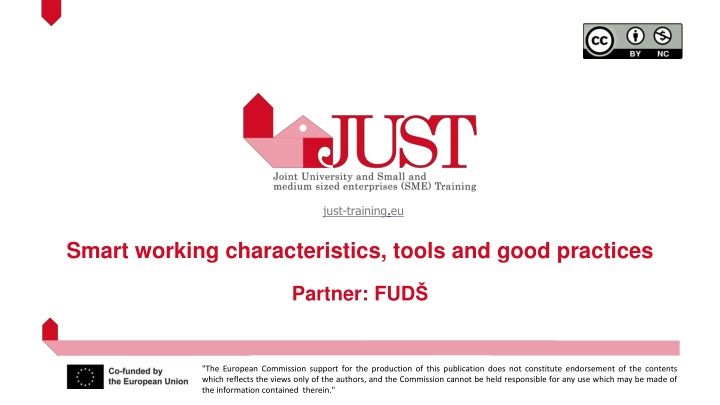
Smart Working Characteristics and Tools
Explore smart working in this module, learning about its advantages, recognizing good practices, choosing proper tools, establishing work-life balance, and managing the smart working environment effectively. This publication focuses on defining Smart Working principles, tools, technologies, setting up a Smart Working place, good practices, and balancing work and personal life.
Download Presentation

Please find below an Image/Link to download the presentation.
The content on the website is provided AS IS for your information and personal use only. It may not be sold, licensed, or shared on other websites without obtaining consent from the author. If you encounter any issues during the download, it is possible that the publisher has removed the file from their server.
You are allowed to download the files provided on this website for personal or commercial use, subject to the condition that they are used lawfully. All files are the property of their respective owners.
The content on the website is provided AS IS for your information and personal use only. It may not be sold, licensed, or shared on other websites without obtaining consent from the author.
E N D
Presentation Transcript
just-training.eu Smart working characteristics, tools and good practices Partner: FUD "The European Commission support for the production of this publication does not constitute endorsement of the contents which reflects the views only of the authors, and the Commission cannot be held responsible for any use which may be made of the information contained therein."
Learning outcomes At the end of this module you will: understand smart working (SW) and its understand smart working (SW) and its advantages and disadvantages advantages and disadvantages recognise recognise SW good practices SW good practices be able to choose proper tools and technology be able to choose proper tools and technology for SW for SW be able to establish a well be able to establish a well- -balanced work/private lifestyle work/private lifestyle balanced understand how to manage SW environment understand how to manage SW environment "The European Commission support for the production of this publication does not constitute endorsement of the contents which reflects the views only of the authors, and the Commission cannot be held responsible for any use which may be made of the information contained therein."
Index SW definition SW definition Defining SW SW principles SW tools and technologies SW tools and technologies Setting up a SW place Tools and technologies for SW SW good practices SW good practices Identification of good practices Balance between SW and personal life SW and wellbeing "The European Commission support for the production of this publication does not constitute endorsement of the contents which reflects the views only of the authors, and the Commission cannot be held responsible for any use which may be made of the information contained therein."
1. SW definition What is Smart Working? What is Smart Working? Smart Working is a business-focused approach to flexible working that delivers more efficiency and effectiveness in work organisation, service delivery and organisational agility, as well as benefits for working people. Key features are management by results, a trust-based culture, high levels of autonomy, flexibility in the time and location of work, new tools and work environments, reduced reliance on physical resources and openness to continuing change. Smart working vs: - Teleworking/remote working Teleworking/remote working - Flexible working Flexible working - Hybrid working Hybrid working - Agile working Agile working "The European Commission support for the production of this publication does not constitute endorsement of the contents which reflects the views only of the authors, and the Commission cannot be held responsible for any use which may be made of the information contained therein."
1. SW definition Work takes place at the most effective locations and at the most effective times he most effective locations and at the most effective times Flexibility becomes the norm Flexibility becomes the norm rather than the exception Everyone is in principle considered eligible for flexible working, without assumptions being made about people or roles Employees have more choice more choice about where and when they work, subject to business considerations Space is allocated to activities Space is allocated to activities, not to individuals and not on the basis of seniority The costs of doing work are reduced costs of doing work are reduced There is effective and appropriate use of technology "The European Commission support for the production of this publication does not constitute endorsement of the contents which reflects the views only of the authors, and the Commission cannot be held responsible for any use which may be made of the information contained therein."
1. SW definition (continued) Simplified collaboration collaboration and connectivity virtually everywhere means sharing information and working with others regardless of location The processes people are asked to work with are continuously challenged make sure they are fit for purpose Managing performance focuses on results focuses on results rather than presence Smart Working underpins and adds new dimensions to diversity and equality new dimensions to diversity and equality principles Employees have the opportunity to lead balanced and healthy lives Work has less impact on the environment. less impact on the environment. continuously challenged to balanced and healthy lives "The European Commission support for the production of this publication does not constitute endorsement of the contents which reflects the views only of the authors, and the Commission cannot be held responsible for any use which may be made of the information contained therein."
2. SW tools and technologies Setting up a SW place Setting up a SW place Smart working as a way to offer new working environments environments to support new work styles. Traditional offices vs. smart office environments. Benefits Benefits of creating smart working place. Desk Desk- -based tasks based tasks: the need for offices is less for ranks of workstations, and more for a mix of other functional spaces. Relevance of understanding the amount of space needed the amount of space needed in the office and the mix of different kinds of spaces of spaces. Protocols for ensuring that space space- -sharing sharing works effectively. Creating activity Creating activity- -based work settings based work settings. new working environments, i.e. attractive and inspiring work mix of different kinds "The European Commission support for the production of this publication does not constitute endorsement of the contents which reflects the views only of the authors, and the Commission cannot be held responsible for any use which may be made of the information contained therein."
2. SW tools and technologies (continued) Considering the needs of staff with disabilities needs of staff with disabilities. Clear desk policy Clear desk policy. Booking system Booking system. Moving from paper-dependency to electronic Office space should be be prioritised for human interaction, not storage. The relevance of ergonomics ergonomics of smart working. Managing noise impact noise impact and considering soundscaping working environment. Managing the needs and challenges of working outside the office Workhubs Workhubs. . electronic- -based working based working. soundscaping as a necessary feature of the smart working outside the office. "The European Commission support for the production of this publication does not constitute endorsement of the contents which reflects the views only of the authors, and the Commission cannot be held responsible for any use which may be made of the information contained therein."
2. SW tools and technologies - Why do we need SW tools and technologies? - Which tools and technologies should you choose? Collaboration and communication tools and technologies: Zoom, Slack, Cisco Webex, Microsoft Teams, Join.me, Loom, TeamViewer Work management tools and technologies: : Basecamp, Trello, Asana, Accelo, Calendly, Toggl, ProofHub, Calendar, Every Time Zone, Harvest GitHub, Facto HR, Doodle Software for cloud storage services Software for cloud storage services and technologies: : Google Drive, Dropbox, OneDrive Password management and technologies: 1Password Note-taking tools and technologies: Evernote, Notion Boosting productivity tools and technologies: Brain.fm, Shift "The European Commission support for the production of this publication does not constitute endorsement of the contents which reflects the views only of the authors, and the Commission cannot be held responsible for any use which may be made of the information contained therein."
3. SW good practices Identification of good practices Identification of good practices SW should be considered as a normal way of working It is relevant to find a proper balance find a proper balance between face-face interaction and virtual interaction. Constant training Constant training of employees should be a norm. It is important to consider the age groups consider the age groups of employees when implementing smart working. Employees should be encouraged to create a dedicated workspace Achieving expected work results Achieving expected work results is more relevant than place, time and manner of working. The importance of setting a KPI (key performance indicator). Employees should be stimulated to become knowledgeable workers relevant information relevant information and select/use proper technology select/use proper technology. Need for keeping regular interaction regular interaction with employees. Relevance of stimulating employees as well as managers to react quickly much as possible. Maintaining sufficient focus on managing the risk in security challenges The relevance of promoting/creating a healthy workplace. healthy workplace. normal way of working. dedicated workspace free of distractions. knowledgeable workers able to search for search for to react quickly and be concise be concise as risk in security challenges. "The European Commission support for the production of this publication does not constitute endorsement of the contents which reflects the views only of the authors, and the Commission cannot be held responsible for any use which may be made of the information contained therein."
3. SW good practices Balance between SW and personal life Balance between SW and personal life Setting up the balance between SW and personal life is important and should be fostered by the organization by: Awareness Awareness- -raising raising sessions for all levels of staff Specific training Specific training in Smart Working techniques for managers and teams The development of team charters or protocols team charters or protocols to involve employees in designing and enforcing their own team arrangements for rolling out Smart Working practices Incorporating Smart Working techniques and principles in leadership development programmes and other relevant professional training Ensuring that recruitment policies recruitment policies support the development of a Smart Working workforce and culture Ensuring that performance management, reward and other people policies erformance management, reward and other people policies support the development of Smart Working. Importance of setting up a work schedule setting up a work schedule in order to balance the working time and free time of an employee. eadership development "The European Commission support for the production of this publication does not constitute endorsement of the contents which reflects the views only of the authors, and the Commission cannot be held responsible for any use which may be made of the information contained therein."
3. SW good practices SW and wellbeing SW and wellbeing Building a SW environment that enables employees wellbeing: 1. Evidence of a positive relationship positive relationship between work flexibility, health and wellbeing. 2. Relevance of good business sense to take care of health and fitness 3. Promoting flexible working practices that can reduce absence 4. Option of remote working and online attendance remote working and online attendance at meetings is beneficial. 5. Two broad areas for promoting health and wellbeing promoting health and wellbeing through workplace facilities: providing wellbeing centres, fitness facilities and areas for relaxation; creating working environments for everyday work that maximise wellbeing. 6. Relevance of paying attention to acoustic acoustic and wider sensory environment. 7. 7. Biophilia Biophilia. 8. Putting noise noise in the right place. health and fitness of employees. reduce absence and in particular reduce stress reduce stress. wider sensory environment. "The European Commission support for the production of this publication does not constitute endorsement of the contents which reflects the views only of the authors, and the Commission cannot be held responsible for any use which may be made of the information contained therein."
3. SW good practices SW and wellbeing SW and wellbeing Threats of SW: Threats of SW: Normalisation od working long hours Being under extreme stress, especially if we ve been doing it for a long time How to help yourself: 1. Take a brake 2. Pay attention to your feelings 3. Reprioritise 4. Consider your alternatives 5. Make changes. "The European Commission support for the production of this publication does not constitute endorsement of the contents which reflects the views only of the authors, and the Commission cannot be held responsible for any use which may be made of the information contained therein."
Summing up Accepting SW as a normal way of normal way of working. working. Creating SW places SW places to bring new working environments and thus many benefits. The selection of proper SW tools SW tools and technologies and technologies is of vital importance. Rather than measuring work time, achieving achieving expected work results expected work results is more important SW: need for knowledgeable knowledgeable workers workers able to search for relevant information information. Positive relationship between SW, health and wellbeing. wellbeing. health and relevant Keeping a healthy work healthy work- -life balance balance is crucial for employee s productivity. life "The European Commission support for the production of this publication does not constitute endorsement of the contents which reflects the views only of the authors, and the Commission cannot be held responsible for any use which may be made of the information contained therein."
just-training.eu Thank you! "The European Commission support for the production of this publication does not constitute endorsement of the contents which reflects the views only of the authors, and the Commission cannot be held responsible for any use which may be made of the information contained therein."





